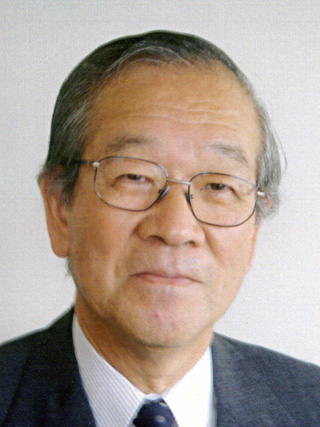Personal Information
Name
YAMAZAKI Toshimitsu

Section
Section II, Fourth Subsection
Date of Election
2005/12/12
Speciality
Physics
Selected Bibliography
- In-Beam Gamma-Ray Spectroscopy. H. Morinaga and T. Yamazaki, Monograph (North-Holland Pub. Co., Amsterdam, 1976)
- Anomalous Orbital Magnetism of Proton Deduced from the Magnetic Moment of the 11- State of 210Po. T. Yamazaki, T. Nomura, S. Nagamiya and T. Katou, Phys. Rev. Lett. 25 (1970) 547.
- Negative Muon Spin Rotation at the Oxygen Site in Paramagnetic MnO. S. Nagamiya, K. Nagamine, O. Hashimoto and T. Yamazaki, Phys. Rev. Lett. 35 (1975) 308.
- Observation of the T/(T-Tc) Divergence of the μ+ Spin-Lattice Relaxation Rate in MnSi near Tc. R.S. Hayano, Y.J. Uemura, J. Imazato, N. Nishida, T. Yamazaki, H. Yasuoka and Y. Ishikawa, Phys. Rev. Lett. 41 (1978) 1743.
- Zero- and Low-Field Spin Relaxation Studied by Positive Muons. R.S. Hayano, Y.J. Uemura, J. Imazato, N. Nishida, T. Yamazaki and R. Kubo, Phys. Rev. B20 (1979) 850.
- First Observation of an Antiferromagnetic Phase in the Y1Ba2Cu3Ox. N. Nishida et al., Jpn. J. Appl. Phys. 26 (1987) L1856.
- Quantum Diffusion of Positive Muon in Copper. R. Kadono et al., Phys. Rev. B39 (1989) 23.
- Discovery of Antiproton Trapping by Long-Lived Metastable States in Liquid Helium. M. Iwasaki et al., Phys. Rev. Lett. 67 (1991) 1246.
- Formation of Long-lived Gas-phase Antiprotonic Helium Atoms and Quenching by H2. T. Yamazaki et al., Nature 361 (1993) 238.
- First Observation of Laser-Induced Resonant Annihilation in Metastable Antiprotonic Helium Atoms. N. Morita et al., Phys. Rev. Lett. 72 (1994) 1180-1183.
- Antiprotonic Helium. T. Yamazaki, N. Morita, R.S. Hayano, E. Widmann and J. Eades, Physics Report 366 (2002) 183-329.
- Quantum tunnelling effects revealed in collisions of antiprotonic helium with hydrogenic molecules at low temperatures. B. Juhasz et al., Chem. Phys. Lett. 379 (2003) 91.
- Deeply Bound Pionic States of Heavy Nuclei. H. Toki and T. Yamazaki, Phys. Lett. 213B (1988) 129 .
- Discovery of deeply bound π- states in the 208Pb(d, 3He) reaction. T. Yamazaki et al., Z. Phys. A355 (1996) 219-221.
- Precision spectroscopy of pionic 1s states of Sn nuclei and evidence for partial restoration of chiral symmetry in the nuclear medium. K. Suzuki et al. Phys. Rev. Lett. 92 (2004) 072302.
- Nuclear Kbar bound states in light nuclei. Y. Akaishi and T. Yamazaki, Phys. Rev. C65 (2002) 044005.
- (K-,π-) production of nuclear Kbar bound states in proton-rich systems via Λ* doorways. T. Yamazaki and Y. Akaishi, Phys. Lett. B535 (2002) 70.
- Super strong nuclear forces caused by migrating Kbar mesons - Revival of the Heitler-London-Heisenberg scheme in kaonic nuclear clusters. T. Yamazaki and Y. Akaishi, Proc. Jpn. Acad. Ser. B 83 (2007) 144.
- Basic Kbarnuclear cluster, K− pp, and its enhanced formation in the p + p → K+ + X reaction, T. Yamazaki and Y. Akaishi, Phys. Rev. C 76 (2007) 045201.
- Indication of a Deeply Bound and Compact K-pp State Formed in the pp -> pλK+ Reaction at 2.85 GeV, T. Yamazaki et al., Phys. Rev. Lett. 104 (2010) 132502.
- New way to produce dense double-antikaonic dibaryon system, KbarKbarNN, through Lambda(1405)-doorway sticking in p + p collisions, T. Yamazaki, Y. Akaishi, and M. Hassanvand, Proc. Jpn. Acad. Ser. B 87 (2011) 362-370.
- Strong binding and shrinkage of single and double Kbar nuclear systems (K-pp, K-ppn, K-K-p and K-K-pp) predicted by Faddeev-Yakubovsky calculations, S. Maeda, Y. Akaishi and T. Yamazaki, Proc. Jpn. Acad. Ser. B 89 (2013) 418-437.
- High-density kaonic-proton matter (KPM) composed of Λ* ≡ K−p multiplets and its astrophysical connections. Y. Akaishi and T. Yamazaki, Phys. Lett. B 774 (2017) 522-526.



